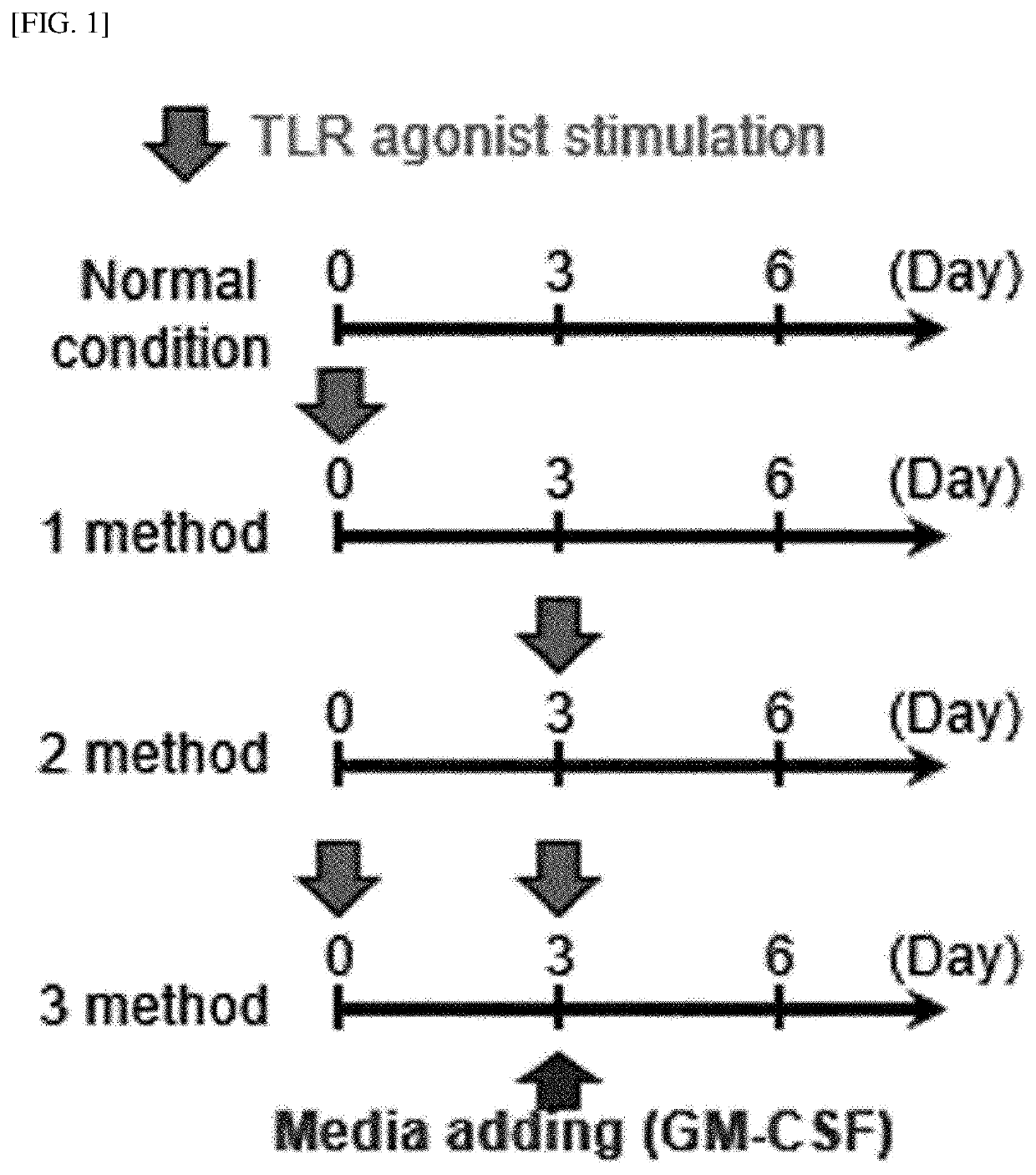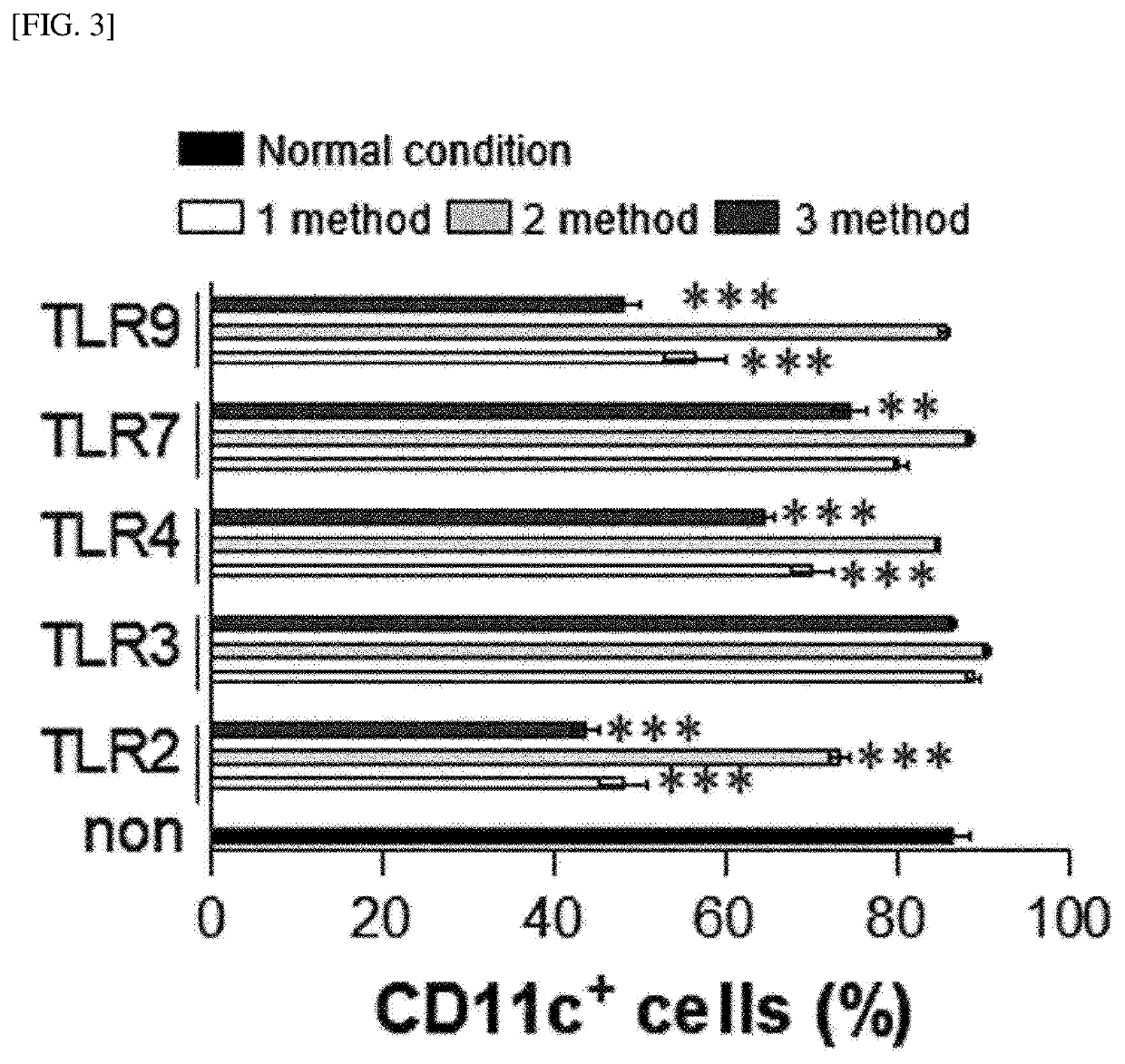Method for producing myeloid-derived suppressor cells, myeloid-derived suppressor cells produced thereby, and methods thereof
a technology of suppressor cells and myeloids, which is applied in the field of methods for producing myeloid-derived suppressor cells, myeloid-derived suppressor cells produced thereby, can solve the problems of insufficient studies on the cytological properties and cell differentiation induction mechanism of these cells, and the clinical effects of dendritic cell therapeutic agents are not yet as expected, and achieves stable supply of large quantities, high yield, and simple and easy process
- Summary
- Abstract
- Description
- Claims
- Application Information
AI Technical Summary
Benefits of technology
Problems solved by technology
Method used
Image
Examples
example 1
[Example 1] Treatment of Bone Marrow Cells with Toll-Like Receptor Agonist
[0251]Whole bone marrow cells in the femurs were harvested from C57BL / 6 mice using a bone marrow harvesting needle. The harvested bone marrow cells were washed with PBS and red blood cells (RBCs) were removed using a red blood cell lysis buffer (Sigma Aldrich). The bone marrow cells were dispensed in a 6-well plate (1×106 cells / ml; 2 ml / well) and cultured, under a condition of 5% CO2 and 37° C., in complete RPMI 1640 (c-RPMI 1640) medium supplemented with 100 U / mL of penicillin / streptomycin (Lonza, Basel, Switzerland), 10% fetal bovine serum (Lonza), 50 μM mercaptoethanol (Lonza), 0.1 mM non-essential amino acids (Lonza), and GM-CSF (20 ng / mL). Here, as illustrated in FIG. 1, each of a TLR2 agonist (Pam3CSK4), a TLR3 agonist (poly I:C), a TLR4 agonist (LPS, from Escherichia coli O111:B4), a TLR7 agonist (imiquimod, R837), and a TLR9 agonist (ODN1826) was added to the medium in an amount of 50 ng / ml at the init...
example 2
[Example 2] Identification of Relationship Between Inhibition of Differentiation into Dendritic Cells and MyD88
[0252]Additionally, in order to identify whether an effect of inhibiting differentiation into dendritic cells is induced in a MyD88-dependent manner, C57BL / 6 mice and C57BL / 6 MyD88− / − mice were treated with a TLR agonist in the same manner as the 3 method in Example 1, to induce differentiation, and then a proportion of CD11c+MHC-II+ cells was measured. The results are illustrated in FIGS. 5 and 6.
[0253]As illustrated in FIGS. 5 and 6, except a case where a TLR3 agonist is applied, in a case where a TLR2 agonist, a TLR4 agonist, a TLR7 agonist, or a TLR9 agonist is applied, a proportion of CD11c+MHC-II+ cells was decreased. However, in a case where MyD88 is knocked out, a proportion of CD11c+MHC-II+ cells was maintained at 80% or higher, indicating that differentiation into dendritic cells is induced.
[0254]From these results, it was found that differentiation into dendritic...
example 3
[Example 3] Phenotypic Analysis of Cells Induced by TLR Stimulation
[0255]The results obtained by analyzing phenotypes of cells harvested after treating bone marrow cells with a TLR agonist in the same manner as the 3 method in Example 1 and performing culture for 6 days are illustrated in FIGS. 7 and 8. As a result, it was found that in the cells induced by TLR stimulation, all dendritic cell phenotypes (CD11c, CD4, CD103, CD8a) decrease, whereas expression of Gr-1, Ly6C, and CD11b is induced at a high level. From these expression patterns, it was predictable that the cells induced by differentiation from the bone marrow cells are myeloid-derived suppressor cells (MDSCs).
[0256]Here, it was found that in a case where among TLR agonists, especially a TLR7 or TLR9 agonist is applied, PDCA-1, a marker of plasmacytoid dendritic cells (pDCs) is highly induced; however, from the viewpoint that B220, another marker of pDCs, shows no significant difference, it can be seen that pDCs are not i...
PUM
| Property | Measurement | Unit |
|---|---|---|
| initiation time | aaaaa | aaaaa |
| initiation time | aaaaa | aaaaa |
| time | aaaaa | aaaaa |
Abstract
Description
Claims
Application Information
 Login to View More
Login to View More - R&D
- Intellectual Property
- Life Sciences
- Materials
- Tech Scout
- Unparalleled Data Quality
- Higher Quality Content
- 60% Fewer Hallucinations
Browse by: Latest US Patents, China's latest patents, Technical Efficacy Thesaurus, Application Domain, Technology Topic, Popular Technical Reports.
© 2025 PatSnap. All rights reserved.Legal|Privacy policy|Modern Slavery Act Transparency Statement|Sitemap|About US| Contact US: help@patsnap.com



